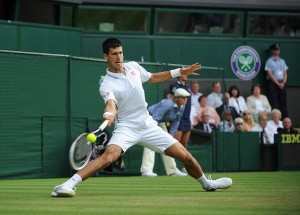Tennis Conditioning – How to Get Fit in Four Steps Without Running
In today’s post APA coach Kostas Tsitmidellis shares his insights on a recent experience he has had working at WimX Tennis Academy as Lead S&C coach, and the challenge of improving the endurance of the players with limited time to get the job done.
Endurance for Tennis
Players were tested using a yo yo intermittent recovery test; if you’re not familiar with this test it is a 20m shuttle-based endurance test that we use at APA to give us confidence that our athletes are fit enough to meet the intermittent endurance demands of the sport of tennis.
Yo-Yo Intermittent Recovery Test Level 1 (YYIRTL1)
• Goal for Pro Males- Level 20.1 IRL1; 17.5 km/h (4.86 m/s)
• Goal for Pro Females- Level 17.2 IRTL1; 16 km/h (4.44 m/s)
For yo-yo to MAS conversion: [1.34*running speed – 2.86] e.g., 1.34*17km/h-2.86 = 19.9 km/h
Based on the targets above, the findings were that the players could do to improve their endurance. I ask Kostas to come up with a plan and here is what he came up with. I’ll pass you on to Kostas 👇
“Before getting into the conditioning progressions and how they can be incorporated into the tennis drills I am going to highlight a couple of points of interest:
- In a singles match there are about 60 high-intensity actions that players need to perform – these include hard and fast decelerations and re-accelerations.
- On the court, players need to be fast enough to reach 6 m/s by their third step of a sprint. If they can do this we are confident they are fast enough.
- Off the court, players need to be fit enough to run at an average speed of 18 km/h for a sustained period of high intensity work- the best male athletes can do this for all 6 minutes on our time trial test. If they can do this we are confident they are fit enough.
- All things taken together, we need players who are fit and fast enough to meet the varied game demands of competitive elite tennis.
So this lead me to consider how best to go about improving the endurance of tennis players? In this article we will be focusing on the endurance part (players capable of reaching 18 km/h, which by the way, is also the speed that the top male athletes get when they meet the requirements of the yo-yo test, 17.5 km/h or higher). We want to train in a way that players get exposure to those higher running speeds to build aerobic fitness but while at the same time preserving speed qualities.
Running vs. Footwork
It is important to mention that the optimum way to reach those cardiovascular adaptations is through running. That is because it is a low skill activity that everyone can do easily, is much easier to individually prescribe (metres covered, time) and subsequently is easier to track progress and periodise for. On the other hand, constraints such as availability of time and sport specificity considerations might discourage a strength & conditioning coach of going for the running option. As well as this, players will not happily appreciate running up and down, and tennis coaches might not be happy witnessing players coming into the tennis training session already fatigued.
Thus, I had a thought on how I could support the tennis coaches incorporate running components into the tennis drills, and following discussion, we came up with some tennis specific conditioning drills. Please note that I am not a tennis coach myself. So those drills were just suggestions and tennis coaches could use them and also develop them.
Stage 1 – Aerobic
What does it look like off the court:
- Continuous runs or long and easy paced intervals > 1-min (80-90% MAS)
What could it look like on-court: (1 vs 1)
- Long and easy rally between two players > 1-min. However, intuitively it sounds better to prescribe tennis players with “ball count” rather than a time. After discussing with the tennis coach we agreed that 40-50 ball rally for 1:00-1:30 minutes seemed reasonable. No mistakes allowed, they have to return every ball!
Stage 2 – Aerobic-Anaerobic
What does it look like off the court:
- Introduction to acidosis and lactic acid consumption in the blood.
- 20-30 seconds all out effort sprinting but with extensive rest after (could be active rest but in the early sessions will probably be passive rest) with 3-minutes to recover. This type of session format is all about giving an early exposure to an anaerobic regime, but with plenty of time to recover so the body can adapt.
What could it look like on-court: (1 vs 2)
- One player on one side of the net and two players down the other end. Players in the pair are considered to be on their “active rest” while they hit to the other person for 20-30 seconds, who will be moved around a lot and will need to sprint to make the balls. The person on their own has to return back every ball. Technically this is an all out effort that someone can sustain for 20-30 seconds.
- Tennis coach will shout “change” which is the cue for the player on their own to walk to the opposite side. When they get there they then have two rounds being part of the pair, before walking back to the singles. That’s 2:30 min of active rest , including the 30-sec to account for the player walking down the other end.
Stage 3 – Anaerobic-Lactic
What does it look like off the court:
- 20-30 seconds high intensity effort, but not as high as Stage 2, because here we will have short rest periods as well, exposing athletes to high levels of lactate for prolonged periods and resisting fatigue. In a running set up this could look like 120-130% MAS with a short active rest (walking or jogging) of 20-30 seconds.
What could it look like on-court: (1 vs 1)
- This can be 1 vs 1 with one of the players only feeding the ball (active rest) and the other player trying to return every ball (again, might be good to measure how many balls they hit)
- Remember, we want this to be a bit easier than Stage 2 because the rest is very short. After 20-30 seconds they swap roles. This is a nice one to sell to tennis players by saying that 20 seconds is how much rest you get in between points in real matches.
Stage 4 – Repeat Sprint Ability
This can be considered an advanced phase where the athletes will be aerobically-anaerobically capable, as seen by their ability to now repeat sprints with short rest periods.
What does it look like off the court:
- 6-10 seconds all out sprint. Work to rest ratio of 1:3 or perhaps 1:2. The aim is to keep the sprint as close to 100% Maximum sprint speed (MSS) as possible but acknowledging that with only 20-30 seconds rest in between this will be challenging.
What could it look like on-court: (1 player basket fed by 1 coach)
- This can be 1 player working on their own with the tennis coach using basket feeding so that the player has to sprint from corner to corner and basically everywhere, and get a racket on the ball.
- Work to rest ratio of 1:3 or perhaps 1:2
Sets and Reps
- For the stages 1-3 we might be looking to do 8-12 reps of the intervals so that the session is around 10 minutes of “intervals” not including any other work such as warm up and cooldown.
- For stage 4, owing to the short work and short rest periods we can prescribe with more repetitions of 10-20 repetitions but broken down into 2 to 3 sets.
What is more, this type of training can be done twice a week, with a different stage each day. For example, stage 1, which can have a more long lasting physiological effect, can be done on one day of the week. Then one of the stages 2-4, which delivers the results , can be done another day later in the week.”
Hope you have found this article useful.
Remember:
- If you’re not subscribed yet, click here to get free email updates, so we can stay in touch.
- Share this post using the buttons on the top and bottom of the post. As one of this blog’s first readers, I’m not just hoping you’ll tell your friends about it. I’m counting on it.
- Leave a comment, telling me where you’re struggling and how I can help
Since you’re here…
…we have a small favuor to ask. APA aim to bring you compelling content from the world of sports science and coaching. We are devoted to making athletes fitter, faster and stronger so they can excel in sport. Please take a moment to share the articles on social media, engage the authors with questions and comments below, and link to articles when appropriate if you have a blog or participate on forums of related topics. — APA TEAM



